Schedule a Call
Get started with your organic growth journey!

.jpg)


In the manufacturing industry, marketing intricate, high-cost products that require specialized knowledge from your customers can be a tough nut to crack.

The challenge is crafting the right message that resonates with the engineers, procurement teams, and decision-makers who need to understand the technical details without getting lost in jargon.
Despite the surge in digital marketing tools, many manufacturers still pour resources into strategies that generate leads that aren't ready to convert. Misaligned content, poor targeting, and outdated tactics all result in wasted time, money, and effort.
This article dives deep into the specific digital marketing problems manufacturers face and provides practical solutions to build a more effective, results-driven marketing strategy that cuts through the noise and brings in the right leads.
Complex Product Marketing: Break down technical features into clear benefits and use visuals, case studies, and educational content to engage your audience.
Manufacturers often face the challenge of marketing highly technical products to a broad audience. Without simplifying product details, you risk alienating key decision-makers who need to understand the product’s value.
The real task is converting complex specifications into clear, relatable benefits.
Challenges:
Solutions:
We can help you create messaging that resonates with your target audience.


B2B manufacturing sales cycles can stretch for months, with multiple decision-makers involved. During this time, staying engaged with prospects is crucial to prevent them from losing interest.
The key is nurturing leads with timely, relevant content at each stage of their buying journey.
Challenges:
Solutions:
With limited resources, manufacturing companies often struggle to maximize the impact of their marketing spend. The solution lies in focusing on high-return, cost-effective strategies that give the most bang for your buck, without cutting corners.
Challenges:
Solutions:
Our team will streamline and automate your marketing efforts to drive better results.


Manufacturers often face a broad and fragmented market, making it tough to pinpoint the right audience. Without clear buyer personas, marketing efforts can miss the mark, wasting time and resources on the wrong leads.
Challenges:
Solutions:
Also Read: The Ultimate Guide to Manufacturing B2B Lead Generation: Proven Strategies and Techniques
Many manufacturers are still relying on traditional methods like trade shows and direct mail. While these tactics have their place, digital marketing strategies are essential to stay relevant in today's fast-moving market.
Challenges:
Solutions:
Let us guide you through the process.


Measuring the success of your digital marketing efforts can feel like a guessing game without clear metrics. Without a solid ROI framework, it's hard to demonstrate the value of marketing initiatives to decision-makers.
Challenges:
Solutions:
The speed of digital marketing evolution can overwhelm any manufacturer trying to keep up. New tools and platforms emerge regularly, and staying agile is key to adapting and keeping your competitive edge.
Challenges:
Solutions:
Let us show you how AI-driven tools can keep you ahead of the competition.


In a saturated market, differentiating your brand is critical. Many manufacturers fall into the trap of using generic messaging, which fails to resonate with prospects and ultimately gets lost in the noise.
Challenges:
Solutions:
Manufacturers face unique challenges in digital marketing, from simplifying complex products to navigating long sales cycles and tight budgets.
While the DIY approach may seem tempting, the reality is that relying on outdated strategies or underdeveloped plans leads to wasted resources and missed opportunities.
Wasting time on ineffective strategies only prolongs your challenges.
Gushwork helps you implement the right tools and strategies for lasting success.


Q1: What are the top digital marketing challenges for manufacturing companies?
A1: Manufacturers often struggle with limited online presence, generating high-quality leads, and adapting to changing algorithms and platforms.
Q2: Why isn't our content converting into sales?
A2: Many manufacturers' content is overly technical, focused on features instead of addressing customer problems, and misaligned with buyer needs at different stages.
Q3: How can we improve our lead generation efforts?
A3: Focusing on SEO, content marketing, and organic social media can help attract targeted traffic without significant costs.
Q4: What role does marketing automation play in manufacturing marketing?
A4: Marketing automation tools help in timely follow-ups, personalized email campaigns, and segmenting audiences effectively to nurture leads.
Q5: How do we measure the ROI of our digital marketing efforts?
A5: Establishing clear KPIs aligned with business goals, using integrated analytics tools, and providing real-time reporting dashboards can help measure performance.
Q6: What are the common mistakes manufacturers make in digital marketing?
A6: Mistakes include believing that content will sell itself, neglecting to promote content actively, and creating content that is too technical or not customer-focused.
Q7: How can we adapt to the fast-paced digital marketing world?
A7: Investing in continuous learning for marketing teams, regularly updating strategies based on industry trends, and adopting agile marketing practices can help manufacturers stay ahead.

Running an appliance repair business means you’re always on the go, fixing appliances, managing clients, and staying on top of everything. But how do you ensure your business gets noticed when people need you most?
Appliance repair SEO helps your business show up at the exact moment potential customers are searching for what you offer. It’s a simple, cost-effective way to bring in more leads, get noticed by more people, and connect with local customers, without piling on more work.
Let’s talk about how SEO can help you attract the right customers and grow your business.
In the appliance repair industry, visibility is everything. SEO will help you achieve it.
If your business doesn’t appear in the top search results when people need your help, you’re missing out on valuable leads.
Here’s why SEO matters:
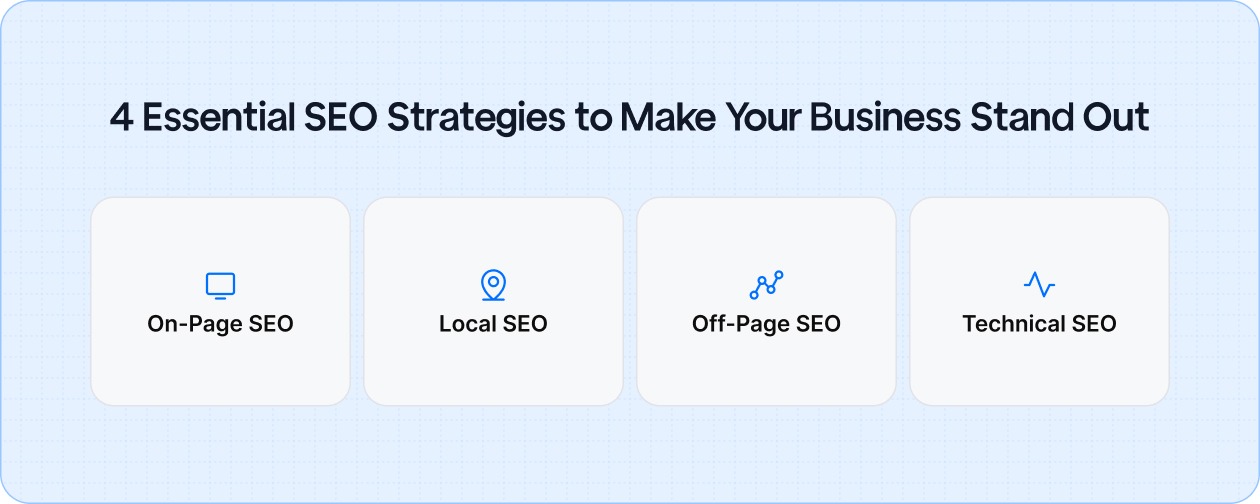
Let’s break down the essential SEO strategies that will help you get found, grow your business, and stay ahead of the competition.
On-page SEO is the foundation of your online presence. If your website doesn't match what customers are looking for, it won't appear in search results.
You need to ensure you’re using the right keywords and creating content that connects with the people actively looking for help.
Here’s how you can make it work for you:
Creating this content can be time-consuming, and it’s easy to miss key opportunities. Having the right strategy ensures you're reaching the people who need your help right when they're ready to make a decision.
Local SEO is the game-changer for appliance repair businesses. Most of your customers are nearby and looking for a local provider. If you’re not showing up when they search for appliance repair services in your area, you’re missing out on a big chunk of potential business.
Here’s how to make the most of local SEO:
By focusing on local SEO, you ensure your business shows up when people in your area need appliance repairs, helping you grow your customer base without competing with national companies.
Off-page SEO is about establishing your business as an authority in your field. One of the best ways to do this is by acquiring backlinks, links from trusted websites that point back to your site.
These backlinks show search engines that your business is reputable and worth ranking higher.
To get the right backlinks:
While these strategies can take time to develop, they’re vital for improving your site’s authority and search rankings. And, doing it right can bring long-term growth for your business.
Technical SEO focuses on the behind-the-scenes work that helps your website run smoothly. While it might seem less important than content or keywords, getting these technical aspects right is essential for your site’s performance and search visibility.
Here’s what to focus on:
These small changes can have a big impact on your rankings and user experience. But getting them right can be tricky without the right technical knowledge.
We optimize every aspect of your technical SEO, along with on-page, off-page, and local SEO strategies, so your appliance repair business stands out.


You’ve put in the work, optimized your website, focused on keywords, and built those local citations. But how do you know it’s all paying off?
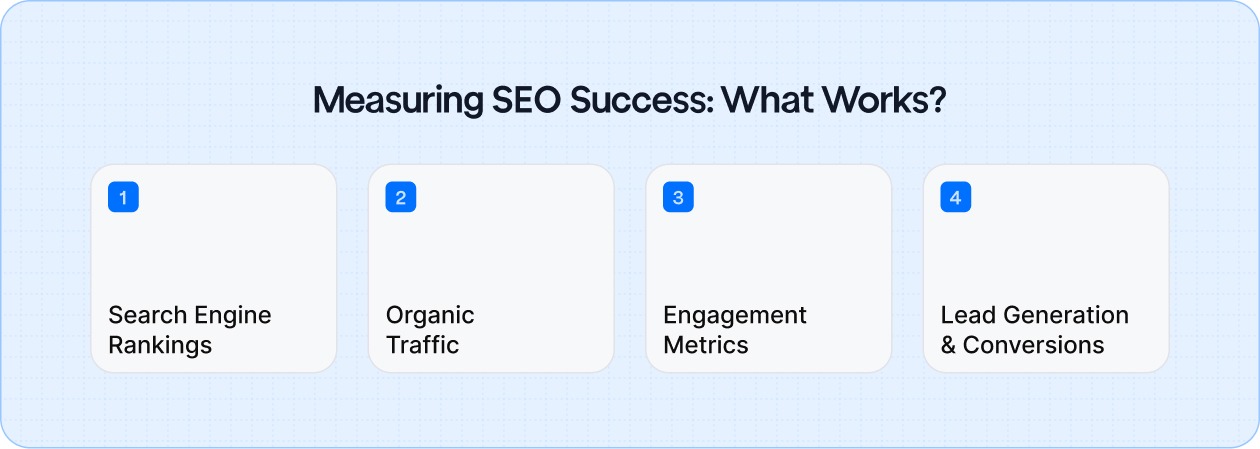
Tracking the right metrics gives you the clarity you need to understand what’s actually working and where you need to adjust.
Here’s what you should be keeping an eye on:
Using the right tools, like Google Analytics and Search Console, gives you a clear picture of where your efforts are succeeding and where you can improve.
You need to track the data, make informed tweaks, and watch your results improve.
Hiring an SEO expert ensures your appliance repair business stays visible, attracts more customers, and grows without taking time away from what you do best.
SEO is always evolving, and staying on top of the latest strategies, trends, and search engine updates can be overwhelming. Without the right expertise, it’s easy to fall behind, missing valuable opportunities to attract more customers.
That’s why many appliance repair businesses choose to partner with SEO experts who can ensure they stay visible online while focusing on delivering quality service to customers.

An expert helps build a sustainable, long-term strategy that drives growth for your business. Here’s why hiring an SEO expert makes sense:
At some point, it makes sense to let the professionals handle the heavy lifting. Teams like Gushwork specialize in SEO strategies that are personalized to small businesses like yours.

With their expertise, you can feel confident that your online presence is in good hands, allowing you to focus on delivering the best service to your customers without the added stress of SEO management.
Let the experts handle it, so you can keep focusing on what you do best.


A1. These services involve optimizing your online presence so people who need repairs can find you when they search. It covers things like improving your website content, making sure your business shows in local results, and helping search engines understand what services you offer.
A2. SEO isn’t instant, but if you stick with the strategy and keep your site updated, you’ll usually start seeing more visibility and inquiries within a few months. The exact timeframe depends on how competitive your area is, how many reviews you have, and what your website looks like now.
A3. Absolutely. Many service‑based businesses that don’t have huge marketing teams invest in tailored, cost‑effective SEO plans. The key is focusing on the services your customers are searching for and optimizing the parts of your business site that matter most.
A4. Paid ads bring immediate visibility, but SEO builds lasting presence. For many appliance repair businesses, combining both works best, with ads for urgent jobs and SEO to consistently attract customers over time.
A5. Yes. Fresh, relevant content helps search engines understand your services and shows you’re active. But it doesn’t mean you need a full blog every week; just a few useful updates, service pages, and local content can make a big difference.
A6. Look for someone with experience in local services, especially home repair or technicians. They should understand your service area, your customers’ needs, and how people search for quick, trustworthy appliance repair help.
A7. You’ll see signs like more visits to your website, more phone calls or form submissions, and better visibility when you search keywords related to your services. The right expert will show you the data clearly and help you decide what to improve next.

The key to grow your carpenter business lies in making sure the right clients can easily find you when they're ready to bring your expertise into their homes or projects.
SEO for carpenters makes sure your business shows up when potential clients are searching for what you offer. With the right strategies, your business can stand out online and attract the customers who need your expertise.
Let’s explore how SEO can help your carpentry business grow by connecting you with customers actively searching for your services.
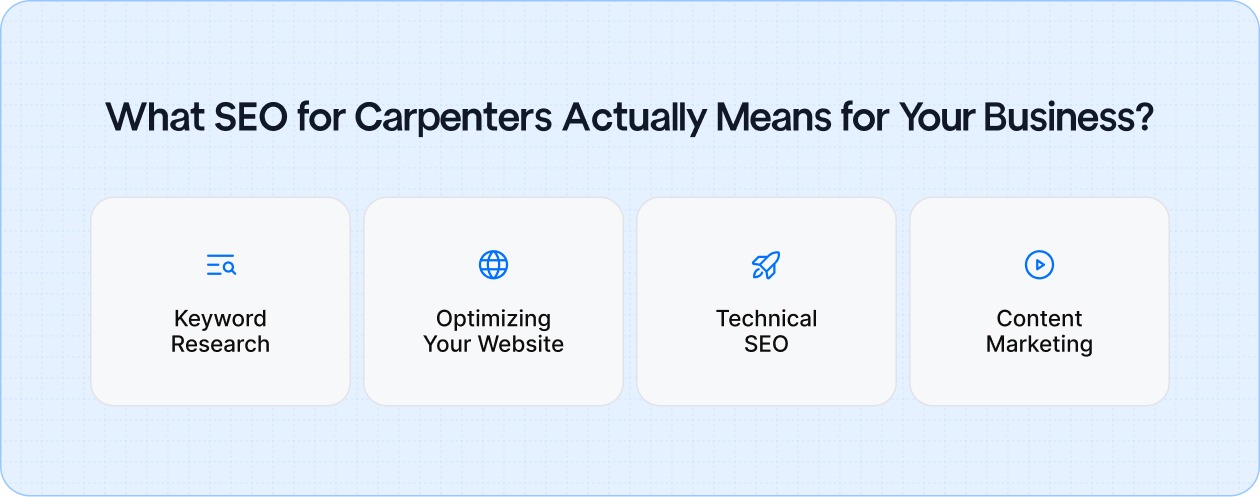
SEO is the key to making sure your skills are seen by the customers who need them. By implementing the right strategies, you can increase your online presence and make it easier for people to find your services when they search.
Start targeting the terms your potential customers are actually using. Learn how to identify the words and phrases that lead customers directly to your business, so you’re not wasting time on the wrong searches.
Your website is a tool to connect with customers. Learn how to make sure it’s set up to be found by search engines and designed to turn visitors into leads.
Website speed, mobile compatibility, and structure are essential for ensuring customers have a smooth experience when they visit. Get the inside scoop on how these factors impact your SEO rankings.
Your content is a chance to show your expertise and attract the attention of both Google and your potential clients. Learn how to create content that resonates with your audience and gets you noticed.
Local SEO is essential for carpenters aiming to attract customers in their community. If your business isn’t appearing in local searches, you’re losing out on valuable opportunities.
Here’s how to make sure you stand out when customers nearby need your services:
Optimizing your Google My Business and Apple Business Connect profiles is critical for local visibility. These platforms make it easier for customers nearby to find you when they’re searching for carpentry services.
Action Steps:
For some, keeping up with these updates and making sure everything is optimized can become overwhelming. It’s easy for small businesses to miss key details that would improve visibility and trust.
Consistency in your NAP (Name, Address, and Phone Number) across all platforms is crucial. Google values uniformity, and your customers rely on it to contact you easily.
Action Steps:
Small mistakes or inconsistencies can easily slip through the cracks without expert help.
Ensuring your NAP is aligned across the web may take some effort, but it can make a significant difference in search results.
Local keywords help your business appear when customers in your area search for carpentry services. These terms show Google that you serve a specific location and are ready to take on nearby projects.
Action Steps:
Identifying the right keywords and ensuring they’re strategically placed can require a comprehensive strategy that targets the right terms. This often needs a professional approach to really make it work for your business.
Backlinks are a key factor in SEO, signaling to Google that other reputable websites trust your content. These backlinks improve your authority and show search engines that your business is credible and worth ranking.
High-quality backlinks are essential for getting noticed by Google. These links act as "votes of confidence" from reputable sites, showing that your business and content are trusted.
Action Steps:
Customer reviews do more than build trust; they directly impact your SEO. Google values fresh, positive reviews, which can improve your visibility in search results.
Action Steps:
A well-aligned SEO strategy, combined with the right content, can make a big difference.


SEO is a continuous process that requires constant monitoring. If you’re not tracking your progress, how will you know if your efforts are truly working?
Here’s how to ensure your SEO strategy is driving the results you need.
Google Analytics is like a treasure map for your website. It shows you exactly where your visitors are coming from and what they’re doing once they arrive. Understanding this flow is crucial for refining your strategy.
Action Steps:
Google Search Console gives you a behind-the-scenes look at how Google views your website. It’s your best tool for understanding which keywords are driving traffic and where your rankings are improving, or falling short.
Action Steps:
With the right strategies, you can turn insights into growth and see real results.


Even with the best craftsmanship, your business can hit a wall if your SEO isn’t on point. The digital world is competitive, and small missteps in SEO can put your carpentry business at a disadvantage.
Let’s look at the common mistakes carpenters make, and why avoiding them is crucial for staying ahead of the competition.
It’s easy to overlook local SEO when you’re focused on perfecting your craft, but not optimizing for your local area can seriously impact your business.
If you aren’t using location-based keywords like "carpenter in Chicago or setting up your Google My Business profile, you’re missing out on clients right in your neighborhood.

Keyword research is key to understanding exactly what potential clients are searching for. Using vague or irrelevant keywords might attract traffic, but it won’t be the kind of traffic that converts into leads.
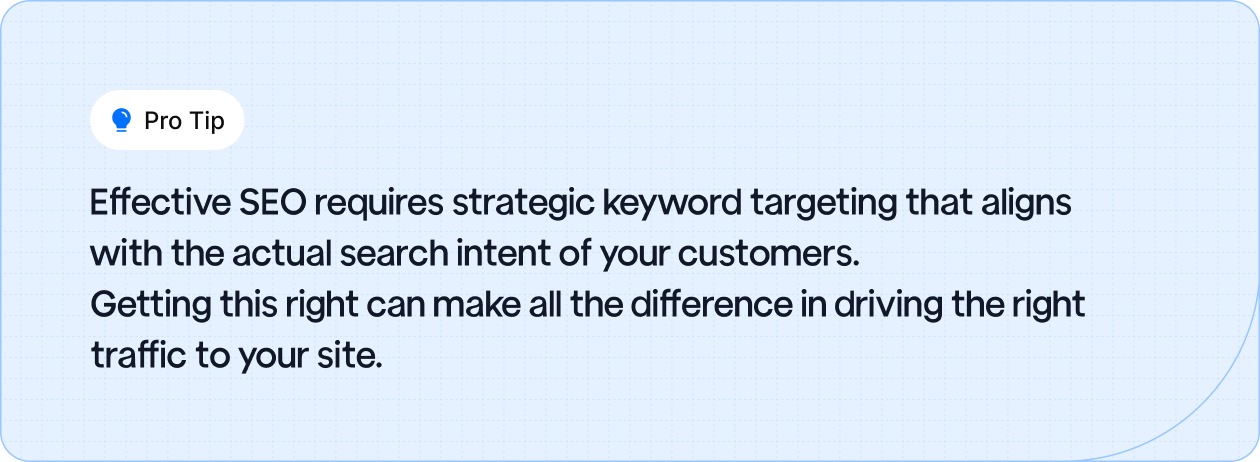
A slow website or one that’s hard to navigate on mobile is a fast way to lose clients. People expect your site to load quickly and work seamlessly on any device. If your website doesn’t meet these expectations, visitors will leave, and Google will lower your rankings.
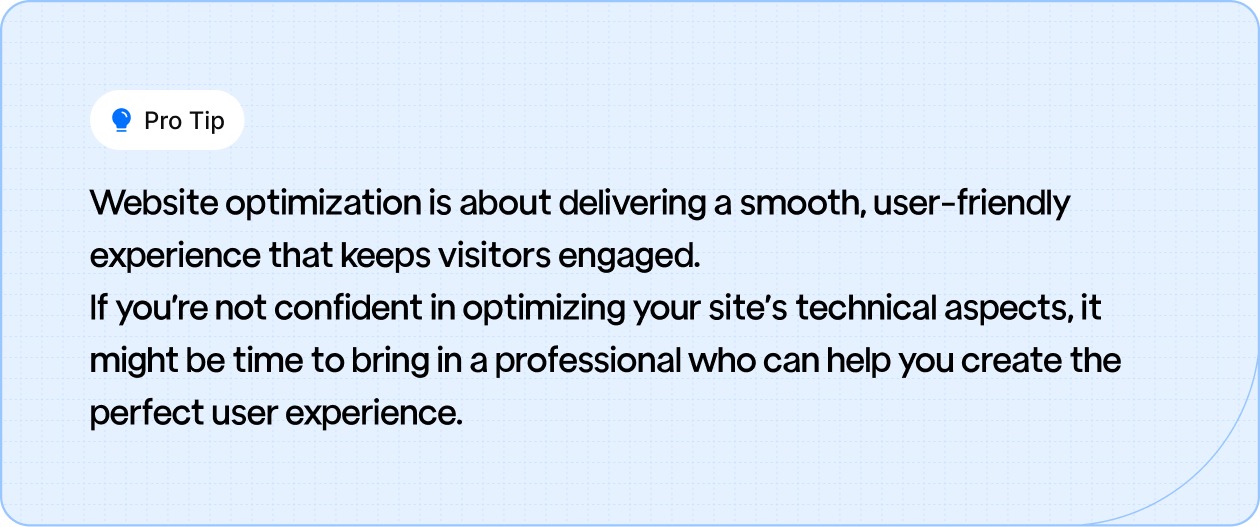
You need to showcase your expertise and provide value to your audience. A lot of carpenters neglect content marketing, focusing only on their services. Without consistent, well-crafted content, you won’t build the authority needed to rank on Google.
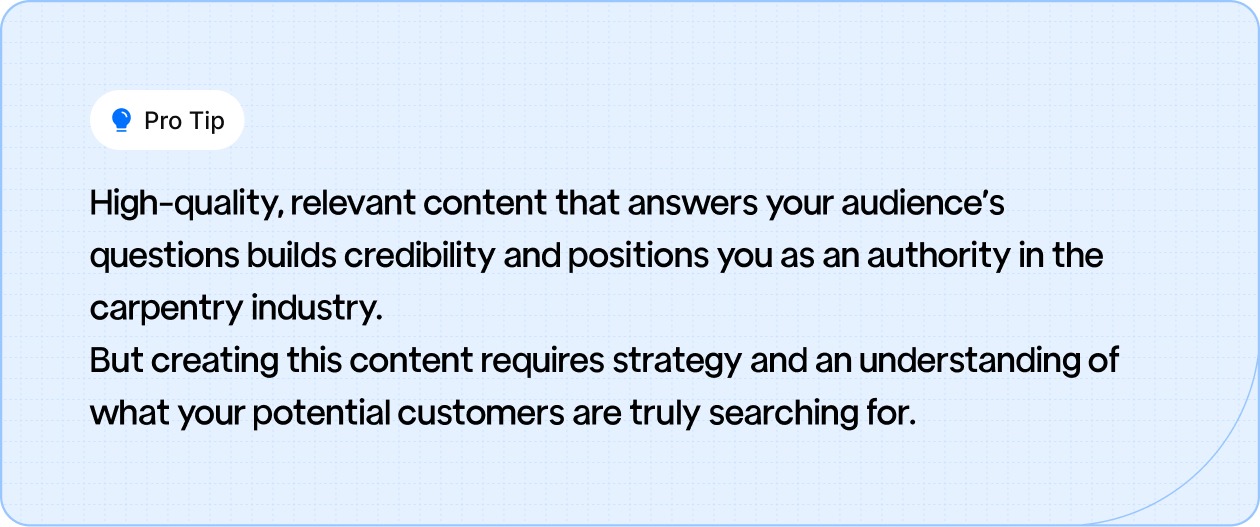
Backlinks are one of the most important aspects of SEO. Without them, your website won’t gain the authority it needs to rank highly.
Many carpenters ignore the value of backlinks or don’t know how to get them.

SEO takes time, strategy, and often the expertise of professionals to ensure your carpentry business is positioned for success in search results. As you fine-tune your website and strategy, remember that taking a holistic, ongoing approach is key.
With the right support, you can overcome these common mistakes and start driving the qualified traffic that turns into customers.
If you’re unsure where to start, consider working with a team that understands the ins and outs of SEO, so you don’t have to do it alone.
SEO is an essential tool for increasing your carpentry business's online visibility. When you optimize your website, you make it easier for customers to find you exactly when they need your services.
By applying these SEO strategies, you can improve your rankings and connect with clients who are searching for your expertise.
SEO can be challenging and time-consuming, especially when you're focused on your work. Gushwork specializes in content-driven SEO strategies that help small businesses like yours grow and get noticed online.
Let Gushwork help you enhance your online presence and attract more customers with content-driven SEO strategies.


A1. SEO for carpenters means making sure your business appears when local customers search for services you offer. It involves choosing the right keywords, optimizing your website and listings for search engines, and creating content that reflects your craftsmanship and service area.
A2. The timeframe varies depending on competition and the work required, but most small carpentry businesses begin seeing improved visibility and inquiries within 3 to 6 months, provided the SEO is consistent and well‑focused on local search and service‑specific keywords.
A3. Yes, regular updates help. While your site’s core services pages might stay the same, adding new content, such as project case studies, service updates, or blog posts, signals activity and relevance. This keeps search engines more confident that your business is active and trustworthy.
A4. You can handle some basic SEO elements yourself, such as claiming your local listings and making sure your address and service descriptions are consistent. But to get lasting results, there are technical, content and backlink factors that often require a level of expertise or external support.
A5. The most frequent error is using generic or overly broad keywords (like “carpenter” or “woodwork”) instead of service‑and‑location focused terms (e.g., “custom kitchen cabinets in Chicago”). Without targeting what your customers are actually searching for, you'll miss the most relevant traffic.
A6. Extremely important. Listings such as Google My Business and Apple Business Connect, combined with genuine customer reviews, strengthen your business’s local presence and trustworthiness. They help you show up in local search results when customers are looking for carpentry services near them.
A7. Absolutely. If your website loads slowly or doesn’t work well on mobile devices, you risk losing prospects right away, and your search visibility can suffer. These technical aspects are often overlooked but make a meaningful difference in how you’re seen online.

To grow your flooring business, gaining visibility online plays a key role in reaching new customers. As more people turn to the internet to find services, you need to be easy to find and relevant to your target audience. The right SEO strategies can help with that.
By improving your position on search engines, you increase the chances that potential customers will find your business. This attracts more qualified visitors, those actively searching for flooring services.
Once they arrive, the goal is to convert these visitors into loyal clients. This guide will explore practical SEO techniques to help your flooring business expand and succeed.
Understanding how homeowners search for flooring services is crucial for aligning your SEO strategy with their needs. Homeowners typically go through a journey, starting with research on flooring options, then comparing prices, and finally seeking trusted professionals.
This search behavior is predictable and actionable, and by mapping out this journey, you can tailor your SEO efforts accordingly.
Actionable Steps:
Leverage AI to create content that directly aligns with homeowner search intent, driving more targeted engagement.


A flooring business's website needs to load quickly, be mobile-friendly, and optimize for images to stay competitive. Many flooring sites overlook key elements such as page speed, mobile optimization, and image SEO, all of which can result in lost traffic and potential customers.
Flooring websites are often heavy with images of products; it's crucial to optimize page speed. If your website is slow to load, you risk losing potential customers to competitors who offer a faster, smoother experience.
Customers expect fast-loading websites, especially when browsing for services they need immediately.
Key Focus Areas for Technical SEO:
Local SEO is a must for flooring businesses. Google prioritizes businesses that are geographically close to searchers. Without proper local optimization, you miss out on customers actively searching for flooring services in their area.
Apple Business Connect also plays a role in local visibility. As more people use Apple Maps to search for local services, ensuring your business is listed correctly on both Google and Apple is critical.
Local SEO is a vital strategy that includes optimizing your Google Business Profile, Apple Business Connect and ensuring that your NAP (name, address, phone number) details are consistent across directories.
Key Steps for Dominating Local SEO:
Flooring customers want detailed, specific information. The key is to create service pages that rank and convert visitors into leads.
Each service page should be highly targeted and organized to answer the exact questions your customers are asking. This approach improves SEO and enhances the user experience by giving visitors exactly what they need to make a decision.
Components of a High-Converting Service Page:
Each product in your catalog is a ranking opportunity. Flooring products like hardwood, tile, and vinyl each provide unique opportunities to target specific searches. When your product pages are optimized with relevant keywords and useful information, you transform your catalog into an SEO tool that generates traffic.
You can make each SKU a potential lead generator by adding useful content like specifications, use cases, installation methods, and maintenance tips.
How to Optimize Product Pages for SEO:
Blogs like “SEO tips for flooring companies” rank well because they answer real, actionable questions homeowners and businesses have. When you provide valuable, targeted content that addresses your audience's specific needs, your site becomes a trusted resource, driving both traffic and conversions.
To build a content engine that attracts the right customers, start by focusing on 7 core blog categories:
How to Map It Out:
Want to create a content plan that works for you?


Visual content, such as images and videos, plays a key role in a flooring business’s online presence. When optimized properly, visual assets can enhance engagement and support your SEO goals.
Key Areas to Focus On:
Many flooring businesses focus too much on high-volume and broad keywords. While those keywords can help with visibility, they don’t always capture the intent of customers ready to make a purchase.
To truly rank and attract qualified leads, focus on intent-led keyword clustering.
Steps to Enhance Keyword Research:
Optimize your keyword research process and target your ideal customers with precision.


User experience (UX) plays a significant role in SEO. Google’s algorithms prioritize websites that provide a seamless, engaging experience for users.
A poor UX leads to higher bounce rates and missed opportunities. Making sure your website is mobile-friendly, easy to navigate, and fast is crucial for keeping visitors on your site longer and for encouraging them to convert.
Key Areas to Focus On:
Backlinks remain a key ranking factor in SEO, but it’s important to focus on quality over quantity. Local backlinks from trusted sources in your community can help elevate your authority and visibility.
These backlinks signal to search engines that you’re a credible business serving the local community.
Effective Ways to Build Local Backlinks:
Let’s develop a strategy to help you build strong partnerships and earn valuable links.


Featured snippets and the "People Also Ask" (PAA) box are prime opportunities to increase visibility. These sections appear at the top of search results, often driving a significant portion of the click-through traffic.
However, many flooring businesses overlook how to capture them. It’s time to systematize this process and make it a key part of your SEO strategy.
Identify Snippet-Worthy Questions:
Content Structure for Featured Snippets:
Why It Works: Google favors content that directly answers common questions, especially when paired with clear, well-structured explanations.
By addressing these queries and using structured data, you set yourself up to claim top spots in search results.
AI is transforming how we approach SEO, but it’s important to understand that AI should support, not replace, human effort. Flooring businesses can use AI-driven tools to enhance their SEO workflow while ensuring quality control remains in place.
Use Cases for AI in SEO:
Guardrails for AI Use:
Use AI to enhance your SEO workflow and create content that truly resonates with your audience.


For flooring brands with multiple showrooms or service territories, scaling SEO effectively is crucial. Having two locations or fifty requires a personalized SEO strategy for multi-location optimization, all while maintaining a consistent brand message.
Key Considerations for Multi-Location SEO:
This structure allows search engines to index your pages more effectively and ensures local searchers easily find each location or service.
Why It Works: Scalable SEO for multi-location businesses requires a balance of consistency and local relevance.
A structured approach to site architecture and content will help you rank across multiple locations without losing your brand’s core identity.
Let’s create a strategy that scales with your business growth.


By now, you've got 13 solid strategies in your toolkit to help your flooring business climb the ranks on Google. Attracting the right customers starts with refining your content to address their questions and optimizing your local presence.
Each step moves you closer to building a reliable, consistent flow of leads.
The key to lasting SEO success is having the right tools and approach. When you align your efforts with the right strategies, you'll see how much smoother the process becomes, leaving you with more time to focus on growing your business and serving your clients.
We’ll help you create content that will show your business at the top of search results on Google.


A1. Aim to respond within 15-30 minutes if possible. Homeowners often decide quickly when they start searching. A prompt response increases your chances of booking the job.
A2. Platforms like local directories and lead marketplaces can help, but they charge per lead, and you’ll still be competing with others. Many professionals see better ROI by improving their own website, Google Business Profile, Apple Business Connect and leveraging referrals.
A3. Focus on intent‑rich phrases like:
These capture users deeper in the decision process, not just those window‑shopping.
A4. Absolutely. Flooring is visual by nature, so high‑quality before/after images, optimized file names, and alt text help your SEO and build trust with potential customers. Contractors have reported better engagement after focusing on visual content in local listings.
A5. Not if you structure your site correctly. Create dedicated pages for each service area, and ensure your service‑area details, NAP (name, address, phone number), and local content are consistent across all pages. This approach works well even with a single physical location.
A6. Referrals remain one of the strongest sources of quality leads. A recommendation from a friend or trusted contractor carries built‑in credibility. Combining referrals with a strong online presence can help keep a steady flow of business.
A7. Use distinct tracking mechanisms:
This data helps optimize your marketing efforts and prevent wasted spend.

Social media marketing can be a powerful tool for landscapers and lawn care providers, even for small businesses with limited resources.
By consistently sharing photos of your work, offering helpful tips, and engaging with your local community, you can connect with potential customers and grow your business.
This guide will show you how to make the most of social media to get noticed and turn online interactions into real customers, without needing a large marketing team.

Choosing the right platforms ensures your time and money are spent reaching the right people. Facebook, Instagram and TikTok provide cost-effective opportunities for local businesses like plumbing.

Before-and-after photos grab attention and demonstrate your expertise. It’s a visual way of proving your worth to potential customers.

Local engagement is vital, and geo-tagging ensures that people in your area find your posts when searching for services.
Let’s help you elevate your local SEO game with the right content strategies.



Positive customer feedback reassures potential clients that you’re a trustworthy choice for their needs.
create an SEO content plan that draws more customers to your business.



Offering helpful tips keeps followers engaged while positioning you as an expert.

A content calendar ensures your social media remains active without overwhelming your team, helping you maintain consistent engagement.
Having a well-planned calendar can make a world of difference. An expert can ensure your strategy is well-aligned with your business goals and helps you maintain consistent content.

These short-form content formats help create a more personal connection with your audience.

Paid ads allow you to target the right people, ensuring your marketing budget is spent efficiently.

Clear CTAs encourage your followers to take action and contact you for your services.
Creating the right CTAs takes practice. An expert can help you optimize them to ensure they resonate with your audience and lead to more business.
Monitoring results ensures your efforts are paying off and helps you refine your strategy for better performance.
Social media is a powerful tool for attracting local leads, building trust, and driving business growth.
By focusing on the right strategies, even small landscaping and lawn care businesses can increase their visibility, engage with their community, and turn online interactions into real-world results.
Let Gushwork help you with personalized SEO and content strategies that drive meaningful results and connect you with the right audience.


A1. For many small businesses, Facebook is the most approachable platform. You can set up a business page, share photos of your work, and join local community groups without a large budget. Instagram comes next, especially if you have strong visuals. Pick one platform to start with, post consistently, and engage with your local community.
A2. Posting 2-3 times a week is a realistic goal for a small team. Focus on quality, share a recent project photo, a tip for homeowners, or a behind-the-scenes look at your crew.
Consistency matters more than daily posts. A smaller schedule you can manage is better than a big plan you can’t keep up with.
A3. Visual proof of your work works well: before-and-after shots, short videos, or a quick post about how you solved a common yard issue. Some clients also like seeing your team in action; people hire people. Add location tags or mention neighbourhoods you serve to help local folks find you online.
A4. Yes, you can run small-budget ads that target your service area. For example, spend $5–$10/day aimed at homeowners in a specific ZIP code who might need lawn or landscaping services. Clear calls like “Get a free quote” or “See our recent work” help make your ad more effective. Track results and pause what doesn’t work.
A5. Use built-in tools in Facebook or Instagram to look at basic numbers: how many people saw your post, how many interacted, and how many reached out. Count how many messages or quote requests you get after certain posts. If one type of post consistently brings in more inquiries, do more of that.
A6. Share helpful tips (e.g., how to choose grass type, how to clean up leaves) or answer common questions homeowners ask. Join local Facebook groups and reply when people ask about yard problems; they’ll see your expertise. Avoid hard-selling in every post; helpful content builds trust and leads to business.
A7. Common mistakes include: posting rarely or irregularly, using only generic stock images, ignoring comments or messages, and choosing too many platforms at once (which dilutes your effort). Focus on one or two platforms you can manage well, show real work, engage, and update regularly.
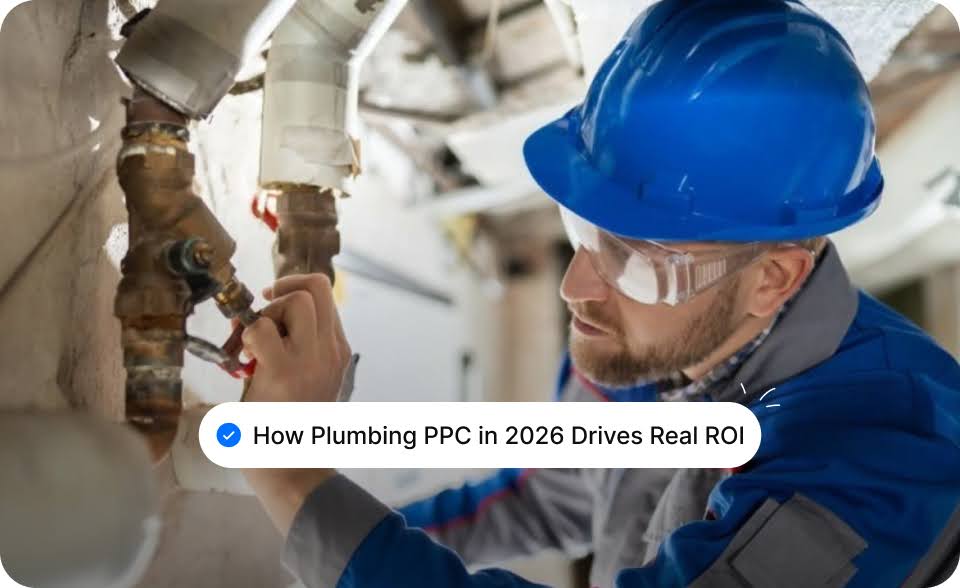
If you're a plumber looking to reach more customers online, pay-per-click (PPC) advertising can help. With plumber PPC, you don’t have to wait for customers to find you; instead, you show up when they're actively searching for services like yours.
It's a straightforward way to get your business in front of potential clients. Plus, with PPC, you only pay when someone clicks on your ad, making it a cost-effective way to get more calls and bookings.
For plumbing businesses that want to grow their online presence, PPC is an easy and effective solution.
Plumbing PPC, or pay-per-click advertising, is a simple way to get your business in front of people who actually need a plumber right now. Your ad appears when someone types something like “emergency plumber near me,” and you only pay when they click on it.
No wasted spend, no assuming who will see your message.
PPC works especially well for plumbers because most plumbing jobs aren’t planned. People search online the moment a pipe bursts, the sink stops draining, or the water heater gives up. With PPC, your business shows up at the exact moment they’re ready to call someone. That means:
To get the most out of your PPC efforts and ensure long-term success, you must consider AI-assisted SEO services that can help drive organic traffic and optimize your strategy for even better results.
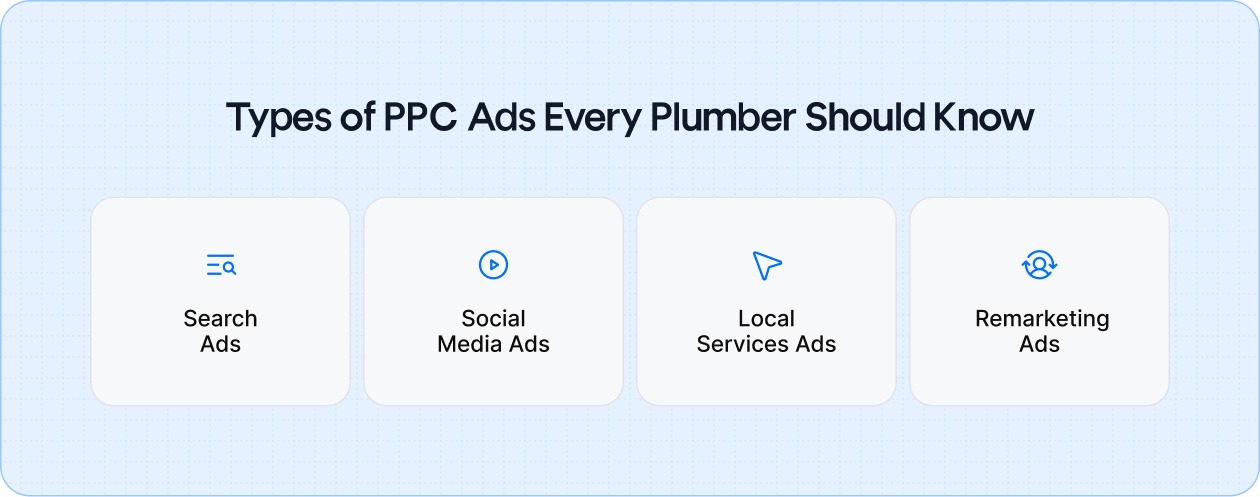
When it comes to PPC ads, there are different types you can use to help your plumbing business gain visibility, attract leads, and grow. Each type targets a unique audience and serves a specific purpose in your marketing strategy.
Let’s take a look at the key types of PPC ads every plumber should consider:
Search ads are perfect for reaching customers who are actively looking for plumbing services right now. These ads appear at the top of Google search results when someone types in high-intent keywords like "plumber near me" or "emergency pipe repair Chicago".
These searchers are looking for help and are ready to hire.
Why it works:
Social media ads, especially on platforms like Facebook, Instagram, TikTok and YouTube, are perfect for getting your business in front of potential customers, even if they aren’t actively searching for a plumber.
These ads allow you to build brand awareness, showcase your work, and engage with your community.
Why it works:
Local Services Ads (LSAs) are an excellent tool for plumbers. These ads appear at the top of Google search results when people search for plumbing services in your area.
The key advantage is that you only pay when someone contacts you directly, either by phone or message.
Why it works:
Remarketing ads allow you to target people who have previously visited your website or interacted with your ads but didn’t take action. These ads keep your plumbing business top-of-mind, giving those visitors another chance to convert into customers.
Why it works:
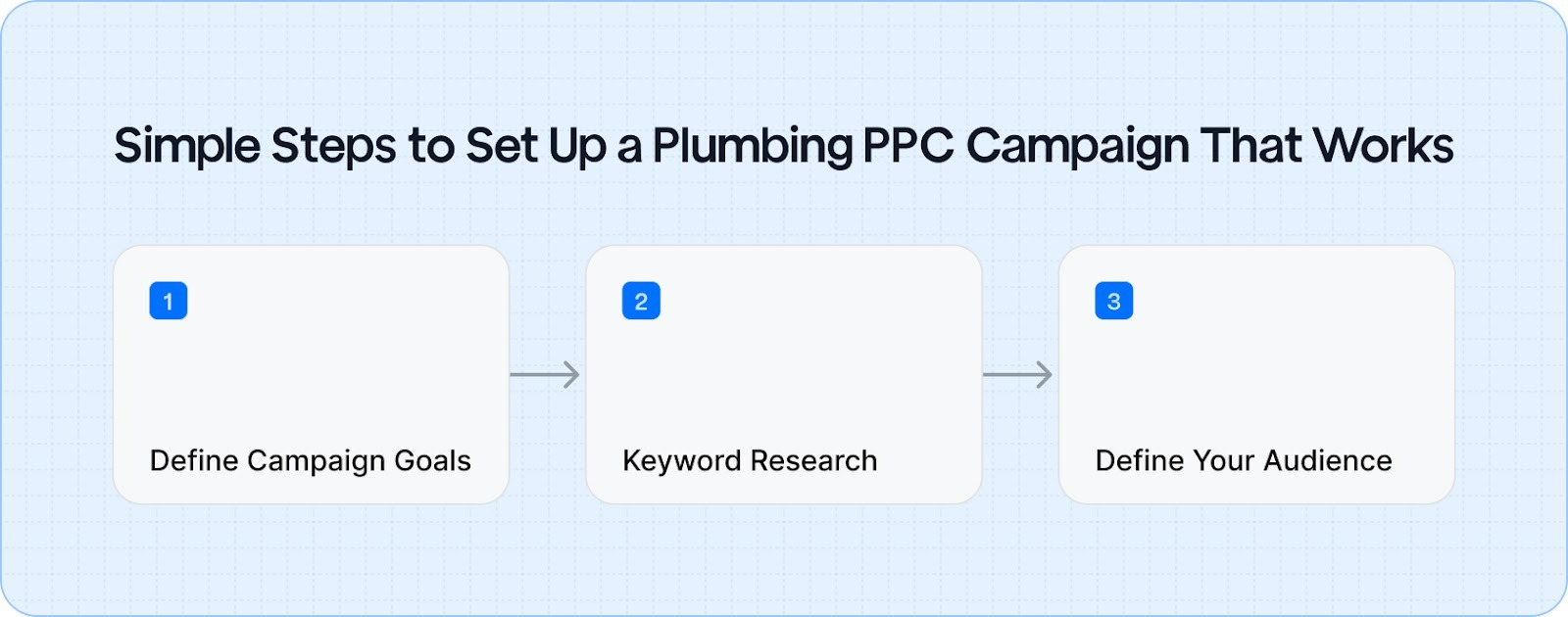
Follow these steps to create a campaign that drives results:
Before diving into your ads, decide what you want to achieve. Are you looking for more calls? Want to generate leads directly? Or maybe your goal is to increase brand awareness? By defining your goals, you can shape every part of your campaign to serve your business objectives.
Having a clear goal means you can measure success and adjust along the way. You'll quickly see what's working, what's not, and where to focus your budget for the best results.
Effective keyword selection is crucial for your PPC campaign’s success. Focusing on the right keywords ensures your ads reach the people who need plumbing services most.
Here's how to do it right:
Long-tail keywords like “emergency plumber near me” or “drain repair in Boston” are more specific and show clear intent. These customers are ready to book, and these keywords usually have less competition, making them more cost-effective.
Target keywords that include your service area. Phrases like “plumber in Dallas” help you connect with people looking for services in your area, increasing conversion rates and reducing wasted spend.
Use specific keywords related to the exact plumbing services you offer, such as “pipe leak repair” or “water heater installation.” This ensures your ads show up for people looking for exactly what you provide.
Look at the keywords your competitors are targeting. This can reveal opportunities to target underused keywords and areas where your competition is excelling.
Target keywords that reflect seasonal plumbing needs, like “frozen pipe repair in winter.” This keeps your business top-of-mind when customers need you most.

Targeting the right audience is key to making your PPC ads work for you. Geo-targeting allows you to focus your ads on people in your local area, so you’re only paying for clicks from potential customers who are close enough to use your services.
Time-of-day adjustments let you control when your ads show up, such as during peak hours for emergency plumbing issues or in the early morning for routine repairs.
This helps make sure you’re not wasting money on ads when people aren’t likely to be looking for plumbing services.
By narrowing your focus to the right local area and time frame, you can ensure your ad spend is as efficient as possible, getting in front of people when they need you most.
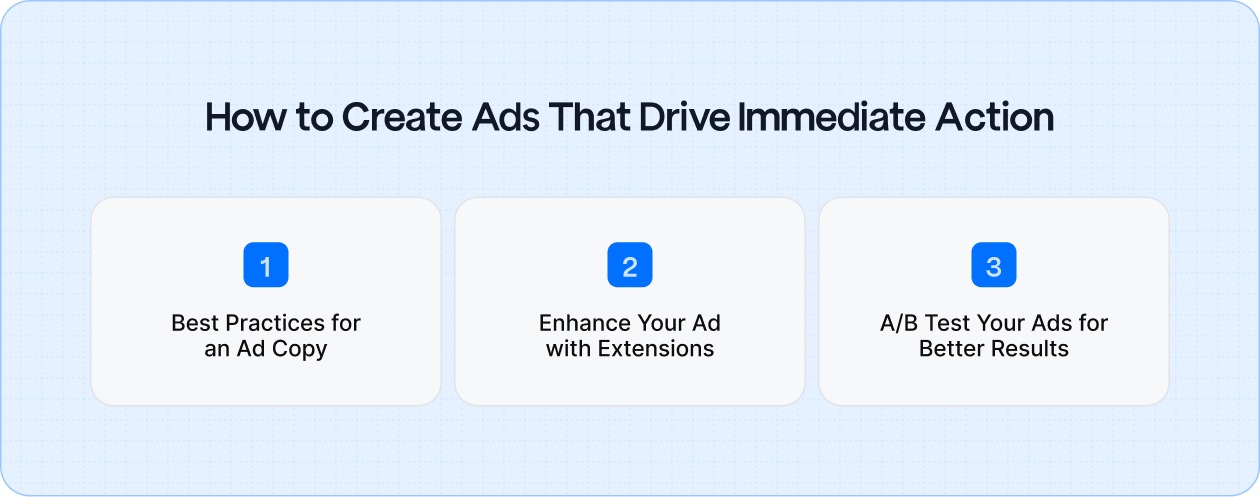
Creating PPC ads that stand out in a crowded space can be the difference between getting a click and getting lost in the shuffle. It’s about making sure your ads speak directly to people’s needs and encourage them to take action.
Here’s how to create ads that work:
When potential customers search for plumbing services, they’re often in a time-sensitive situation. Maybe their pipes just burst, or their water heater stopped working in the middle of the night.
This is where your ad copy needs to speak directly to their urgency. Use words that evoke a sense of immediacy, like “24/7 Emergency Plumbing, Call Now” or “Same-Day Service Available, Call Us Today”.
Why it works:
Remember, you’re offering a solution to a problem. The clearer and more urgent your message, the more likely people are to call.
Ad extensions are a simple and powerful way to provide more information in your ad without cluttering the main copy. These extra details, like phone numbers, location, and site links, make it easier for potential customers to reach you and find exactly what they need.
Why it works: These extensions add more touchpoints for customers to engage with your ad. The more accessible and informative your ad is, the more likely people are to click through.
By testing different variations of your ads, including headlines, calls-to-action (CTAs), and visuals, you can discover which versions resonate most with your target audience.
What you should test:
Why it works: By testing and optimizing your ads, you can ensure that each ad you run is fine-tuned to perform its best. Even small tweaks can make a big difference in conversion rates.
A successful PPC campaign begins with smart budgeting and effective bidding strategies. By setting realistic goals and continuously optimizing your keywords, you can make sure every dollar spent drives meaningful results for your plumbing business.
Knowing your budget range is key to effective PPC. For most plumbing businesses, this can range from $1,500 to $10,000 per month, depending on size and competition. Start small, track results, and scale based on what works.
Choose the right bidding strategy to get the best value for your spend.
Monitor which keywords are bringing in quality leads and increase your budget for those high performers. This ensures your ad spend is focused on what drives results.
When it comes to managing your PPC campaigns, the decision to handle them in-house or bring in a professional can significantly impact your results. For small plumbing businesses, DIY PPC can be a cost-effective solution if you're willing to dedicate time and effort.
However, as your business grows and your campaigns become more complex, you might find that expert help can deliver more efficient and effective results.
Here's a breakdown of the key differences to help you decide which option best suits your needs.
| Criteria | DIY PPC | Hiring an Expert Agency |
|---|---|---|
| When It's Right for You | Best for businesses with a small budget who are willing to put in the time and effort to manage their own ads. | Best for businesses that want to scale quickly, have a larger budget, or need more advanced expertise. |
| Control Over Campaign | Full control to manage and adjust ads directly, giving you flexibility in real-time. | Experts handle all aspects, from keyword research to ad management, ensuring all adjustments are professionally made. |
| Time Commitment | Requires significant time for research, constant monitoring, testing, and optimization. | Saves time by handling all PPC tasks, allowing you to focus on running your business. |
| Complexity | DIY PPC works for simpler campaigns, but becomes harder to manage as complexity grows. | Agencies bring expertise to navigate complex campaigns and ensure optimal performance. |
| Cost Efficiency | Can be cost-effective for smaller campaigns with limited budgets. | May cost more, but agencies maximize ROI through optimized campaigns. |
| Expertise | Limited expertise; you learn as you go and may miss deeper optimization opportunities. | Agencies offer proven strategies, advanced methods, and deep industry experience. |
| Scalability | Scaling is challenging due to manual workload and increasing complexity. | Agencies have resources to scale campaigns efficiently as your business grows. |
| Why It Works | DIY PPC works when goals are small and you want total control. But as campaigns expand, results may plateau. | Agencies ensure campaigns are fully optimized, saving time while maximizing performance and ROI. |
While PPC is effective for immediate visibility, building a strong foundation with SEO-driven content can enhance your results over time. Creating high-quality, optimized content that ranks well in search engines can naturally draw more traffic to your website, reducing your reliance on paid ads.
This long-term strategy strengthens your overall online presence, increasing the chances that paid clicks lead to conversions.
Combine expert PPC strategies with SEO-driven content to maximize your results and grow your business.


PPC for plumbers can deliver fast results by turning clicks into valuable leads. With the right ad types, a clear budget, and continuous optimization, your plumbing business can experience real growth.
PPC helps you connect with local customers who are actively looking for plumbing services, and with regular adjustments, you can make sure your investment continues to pay off.
A well-planned plumbing PPC campaign ensures you’re getting the most out of your advertising efforts. Starting out or aiming to expand, taking a strategic approach will help you reach more qualified customers.
Get in touch with Gushwork to explore how content strategies and SEO optimization can help maximize your results.


A1. PPC (Pay-Per-Click) for plumbing businesses involves running ads that target potential customers searching for plumbing services. You only pay when someone clicks on your ad, making it an efficient way to generate leads.
A2. Focus on location-based long-tail keywords like "emergency plumber near me". These types of keywords attract high-intent customers actively looking for services.
A3. The budget can vary, but most plumbing businesses spend between $1,500 to $10,000 per month, depending on their location, competition, and goals. Start with a smaller budget and scale as you see results.
A4. Yes, you can run a DIY campaign, but managing it effectively requires constant optimization, keyword research, and tracking. As your business grows, hiring an expert can help you maximize ROI.
A5. Search Ads, Local Services Ads (LSAs), and Social Media Ads are highly effective. Search Ads target customers actively searching for plumbing services, while LSAs help with local, high-intent leads.
A6. Use tools like Google Analytics to monitor key metrics such as click-through rate (CTR), conversion rate, and cost per lead (CPL). Tracking these metrics allows you to adjust your strategy and improve performance.
A7. First, review your ad copy, keywords, and landing pages to ensure they align with customer intent. Consider adjusting your bids, testing new keywords, or using remarketing ads to reach past visitors.

A steady stream of high-quality leads can make all the difference between a busy month and a slow one.
For those in the electrical industry, finding the right projects at the right time is crucial for keeping business flowing smoothly. However, many electricians struggle with outdated methods or miss valuable opportunities due to unclear lead generation strategies.
This guide will walk through practical, proven strategies to help you generate more electrician leads, so your schedule stays full and your business continues to grow.
To grow your business, you need to attract the right leads, those who are genuinely interested in your services. Without a clear understanding of the type of work you want, you could end up wasting time on calls that don't turn into paying customers.
By focusing on the right type of leads, you can create content and marketing strategies that are more effective in bringing in the customers who truly need your services.
Emergency calls tend to be urgent and can come with higher pricing, but planned work is generally more predictable. Knowing what kind of work you want to focus on can help you decide how to market your services.
These contracts often involve fewer but larger projects. The sales cycle may be longer, but the contracts are typically more stable and offer bigger returns. Focusing on these can lead to better and steadier work for your business.
It's crucial to know the difference between high-value work that pays well and low-margin projects that take up too much time without offering much profit. Focusing on high-value projects means better returns on your efforts.
Adjusting your content to target the right customers can make a big difference.


Before you start focusing on getting more people to visit your website, make sure that your website and online presence are set up to convert those visitors into customers.
Having a strong digital foundation ensures you're getting the right traffic that can turn into actual business.
Make sure that your service areas, business hours, and what you offer are clearly visible on your website and other online platforms. This helps potential customers know exactly what you offer and when you're available.
Your website should make it easy for visitors to contact you. This means having prominent call-to-action buttons, simple forms, and trust-building elements like reviews and certifications that reassure potential clients.
Make sure you never miss an important call. Having clear phone scripts and a system in place to manage voicemails ensures that even if you’re unavailable, potential clients can still reach you.
Word-of-mouth from happy customers is one of the most reliable ways to get new business. When your clients are satisfied, they're more likely to recommend you to others.
Encouraging this can create a cycle of referrals that helps you grow without having to spend extra on ads.
After completing a job, ask your customers if they know anyone else who might need similar services. A simple and direct request is often all it takes to get new leads.
Offering small rewards, like gift cards or priority booking, can motivate customers to refer others without hurting your bottom line. It’s a win-win: you get more leads, and your customers get something in return.
Work closely with realtors, property managers, and general contractors. When they see how easy you are to work with, they’ll be more likely to recommend your services to their clients.
Having complete and accurate profiles on platforms like Google Business Profile and Apple Business Connect is key to showing up where your customers are searching.
These profiles are often the first thing potential customers see when looking for local services. Keeping them updated helps increase your visibility and builds trust.
Both of these platforms should include up-to-date service areas, hours, and contact information. This ensures customers know exactly where you are and how to reach you.
Positive reviews play a significant role in your online visibility. Encourage customers to leave reviews, and always respond to them to build trust with future customers.
Use photos of your work, post regular updates, and answer frequently asked questions on your profiles. This helps potential clients make decisions quickly without having to call first.
Local SEO ensures that your business shows up when people search for specific services in their area. By targeting the right search terms and creating pages that meet those needs, you’ll attract traffic that’s more likely to convert into real business.
Focus on specific keywords like “emergency electrician near me” or “electrical repair in Chicago” that show people are ready to book a service.
Create dedicated pages for the services you want to focus on, such as “EV charger installation” or “panel upgrades,” so customers know exactly what you offer.
Use real project examples, photos, and testimonials from clients in specific locations to build trust and improve your local SEO.
Strong content starts by addressing the real problems and decisions your customers face.


Attracting the right electrical projects starts with creating content that speaks directly to the needs of your potential clients. By answering their questions and providing valuable insights, you position yourself as an expert, ready to solve their problems.
The goal is to ensure that when customers search for electrical services, your content is what they find.
Homeowners are likely to search for practical information before making a decision. Your content should focus on topics such as:
These questions should guide your blog topics, positioning you as the go-to expert in your area.
With expert guidance, your content can speak directly to your target audience's needs.


Videos are a great way to showcase your expertise. Short how-to videos or explainer videos help homeowners understand their issues and your services.
For example, a video on “How to identify a faulty breaker” or “The steps involved in a panel upgrade” can build trust and encourage viewers to reach out for help.
Case studies are especially valuable for larger projects. Sharing before-and-after photos, timelines, and outcomes helps commercial and industrial clients understand what they can expect from working with you.
This builds credibility and makes it easier for decision-makers to choose your business over competitors.
Social media is often overlooked as a serious lead-generation tool. However, platforms like Facebook, Instagram, and Nextdoor can help you connect with homeowners and local businesses who need electrical services.
When done right, social media can bring in a steady flow of qualified leads.
Keep your social media feeds engaging with a mix of content, such as:
This kind of content shows potential clients that you’re active, trustworthy, and capable of handling their electrical needs.
Engage with local Facebook and Nextdoor groups by answering questions, providing safety tips, and offering advice, without pushing your services too aggressively.
Position yourself as an expert by providing helpful, insightful responses that demonstrate your knowledge.
DMs and comments are easy to miss if you’re not careful. Set up a simple system to track all social inquiries and move them into your CRM for follow-up. This ensures no opportunity slips through the cracks.
Paid ads can bring in a lot of leads, but they need to be carefully managed. When used correctly, they can target people who are actively looking for electrical services in your area. Here’s how to make the most out of paid advertising.
Google Local Services Ads (LSAs) are a great way to get your business in front of people who are actively searching for services like yours.
Make sure you meet Google’s requirements for verification and reviews, and track the results to ensure it’s a good investment.
Google Ads can be especially useful for emergency work or high-demand services like panel upgrades or seasonal projects.
Consider running call-only campaigns to let potential clients contact you immediately, or landing-page campaigns to direct them to detailed service information.
Even when there isn’t an emergency, you can use social media ads to keep your business top of mind. Promote your services, offer seasonal discounts, or retarget previous visitors with special offers.
This way, your business is always visible when someone needs an electrician.
Lead marketplaces like Angi, HomeAdvisor, and Thumbtack can be helpful for finding new customers, but you need to approach them carefully to ensure you're getting the best return on investment.
These platforms can connect you with potential clients, but they come with fees and often require you to compete with other service providers.
It’s important to evaluate if these platforms are bringing in quality leads and adjust your strategy accordingly.
Being quick to respond is crucial when using lead marketplaces. A prompt reply, combined with well-crafted scripts and personalized quotes, can make the difference between winning the lead and losing it.
By addressing the potential customer's needs right away, you increase your chances of turning inquiries into actual jobs.
Track your ROI carefully. If a marketplace isn’t delivering quality leads or if the cost per lead is too high, it may be time to scale back your investment or drop it altogether.
Offline marketing, when combined with your online efforts, can create a powerful, multi-channel lead-generation strategy.
Your branded service vehicles, uniforms, and yard signs are all opportunities to market your business wherever you go. Make sure they include your contact details and are easily visible.
Traditional marketing methods like door hangers and mailers still work, especially when paired with QR codes or unique tracking links that direct customers straight to your website or booking page.
Sponsoring local events or hosting workshops is a great way to build awareness and establish trust with your community. These efforts can turn into valuable leads without much upfront cost.
A delay could lead to losing the job to a more responsive competitor.
Establish clear goals for how quickly you respond to each type of inquiry. The faster you respond, the more likely you are to convert the lead into a customer.
Having pre-written templates for quotes, follow-ups, and reminders can save time and ensure your communication is always consistent and professional.
Set up a system for routing calls and managing voicemails to ensure potential customers can always reach you or get the information they need, even outside of business hours.

Building a steady flow of leads takes time and a structured approach. This 90-day plan will guide you through the key phases to ensure that your efforts are focused and effective.
Start by setting up the foundations of your digital presence:
These steps ensure you're prepared for the next phases and can track the success of your efforts.
Once your basics are in place, focus on organic lead-generation channels:
This phase will help build lasting, cost-effective channels that continue to bring in leads over time.
Now that your organic channels are in place, complement them with paid campaigns:
This phase helps accelerate your lead flow, driving more immediate results while refining your ongoing strategy.
Consistent lead generation is the key to keeping your electrical business growing, especially in a competitive market. By focusing on building long-term, reliable lead streams, you ensure that your business remains visible and relevant to the right customers.
A balanced approach of free strategies like referrals, SEO, and social media, paired with paid methods such as Google Ads and Local Services Ads, can help you build a sustainable and scalable lead generation system.
This combination ensures you're attracting high-quality leads while optimizing your resources for maximum efficiency.
Let Gushwork help you in creating a content strategy that attracts and converts high-quality leads consistently.


A1: Generating leads starts with ensuring your business is easy to find. Focus on local SEO, optimize your Google Business Profile, and encourage satisfied customers to leave reviews. Content marketing, like blog posts and videos, also helps attract organic traffic. Paid ads and lead services can bring in quick results, but a strong, consistent organic presence is key to long-term growth.
A2: Local SEO helps your electrical business show up in searches specific to your service area. By optimizing your Google Business Profile, using location-based keywords, and encouraging reviews, you increase your chances of appearing at the top of local search results. This can lead to more calls and visits from people looking for electricians nearby.
A3: Both are important. Organic marketing, such as SEO and social media engagement, builds long-term, sustainable traffic. Paid marketing, like Google Ads and Local Services Ads, can give you quick visibility for high-demand services. A balanced approach that combines both is often the most effective strategy.
A4: Focus on creating content that answers common questions and addresses the pain points of your target customers. Blog about topics like safety tips, cost breakdowns, and how to choose the right electrical services. Video content and project case studies are also great for showcasing your expertise. Ensure your content includes location-specific keywords for better local visibility.
A5: Quick follow-ups are crucial—responding to inquiries within minutes can significantly increase your chances of closing the deal. Make sure your website is designed to convert, with clear CTAs (calls to action), easy contact options, and trust signals like testimonials. Also, offer incentives for referrals and repeat business to keep customers coming back.
A6: Social media platforms like Facebook and Instagram allow you to showcase your work and engage with your community. Posting before-and-after photos, customer testimonials, and helpful electrical tips keeps your audience engaged. You can also use social media ads to target specific customer demographics, further driving leads.
A7: Use tools like Google Analytics to monitor website traffic and conversion rates. Track key metrics such as click-through rates (CTR) for ads, number of calls generated, and form submissions. Set up tracking for all paid campaigns and organic channels to understand which efforts are bringing in the most valuable leads, so you can adjust your strategy accordingly.












%201.avif)

%201.avif)










.svg)
.svg)

Copyright © 2025 Regents Inc & Delfin Technologies India Private Limited | All Rights Reserved
.svg)

